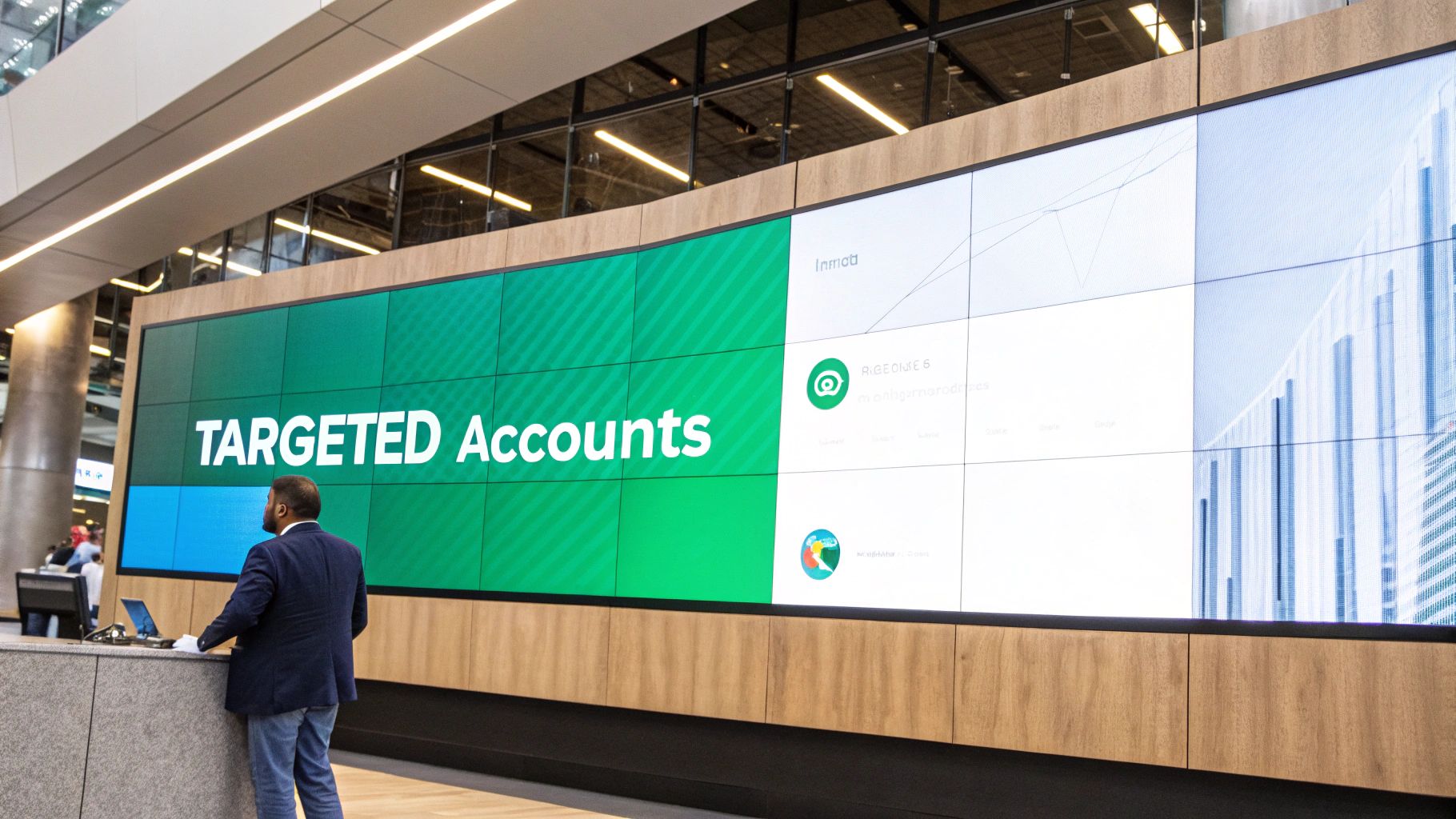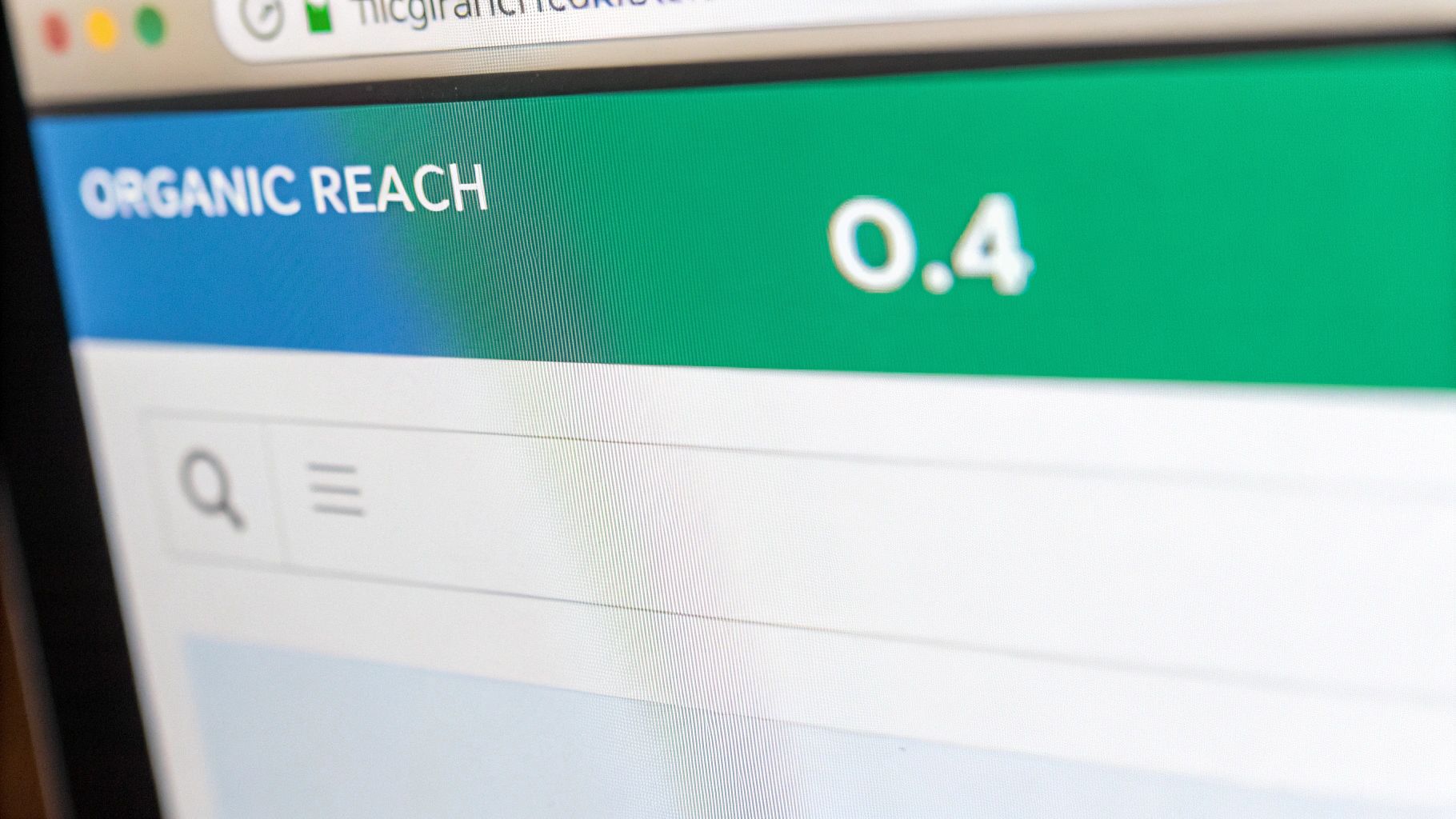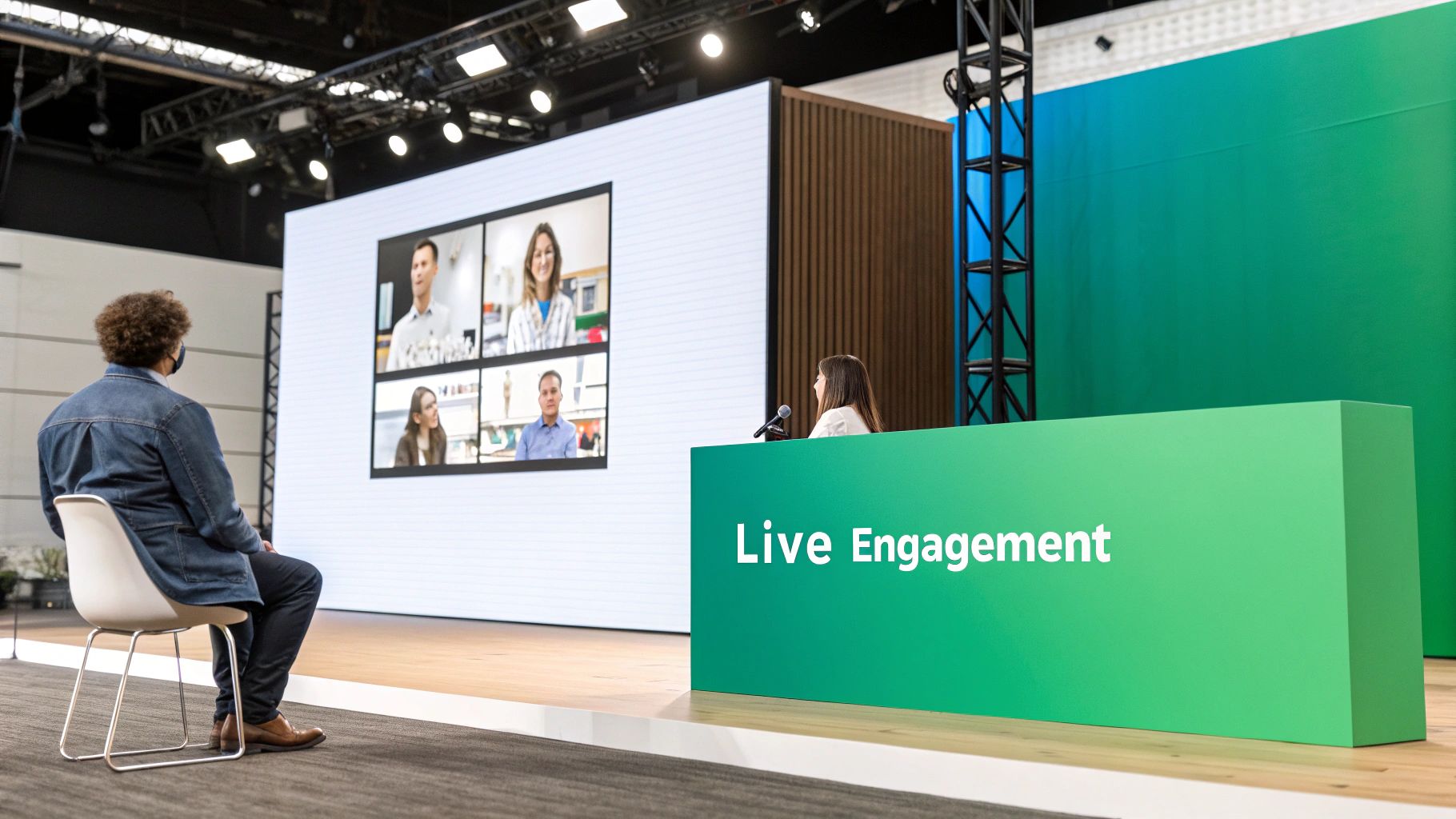9 High-Impact Demand Generation Tactics for 2025
In today's crowded marketplace, simply being present isn't enough. True growth stems from creating a sustained, predictable pipeline of interested prospects, a process known as demand generation. This isn't just about finding leads; it's about building awareness and cultivating genuine interest in your products and services long before a potential customer is ready to buy.
Effective demand generation tactics are the lifeblood of a healthy business, turning passive observers into active, engaged buyers. However, with countless strategies available, which ones truly move the needle and deliver measurable results? It’s easy to get lost in a sea of options, from content marketing and SEO to account-based marketing and social media engagement. The key is to move beyond theory and focus on practical, repeatable actions that build momentum.
This article cuts through the noise to detail nine proven, high-impact demand generation tactics. We will explore each strategy with a focus on practical implementation, real-world examples, and actionable steps you can take immediately. Whether you're a solopreneur, part of a small marketing team, or a sales leader, you'll find clear guidance to build a powerful demand engine for your business. Let's dive in.
1. Content Marketing
Content marketing is a strategic approach focused on creating and distributing valuable, relevant, and consistent content to attract and engage a specific audience. Unlike direct advertising, this method provides genuine value upfront, building trust and establishing your brand as a go-to authority in your niche. By addressing your audience's pain points and questions, you create an inbound pipeline of educated prospects who are already familiar with your brand when they are ready to buy. This is one of the most foundational demand generation tactics because it fuels nearly every other marketing channel, from SEO to social media.

Why It Works for Demand Generation
Content marketing excels at generating demand by capturing attention at the top of the funnel, long before a prospect is actively looking for a solution. It educates the market, creates brand affinity, and nurtures potential customers through their buying journey. A prime example is HubSpot, whose extensive blog and free resource library attract millions of visitors, converting many into leads and customers for their CRM platform.
Actionable Implementation Steps
- Map Content to the Buyer's Journey: Create content for each stage: blog posts for awareness (top-of-funnel), case studies for consideration (middle-of-funnel), and product demos for decision (bottom-of-funnel).
- Embrace the "They Ask, You Answer" Philosophy: Identify the most pressing questions your customers ask your sales and support teams. Turn these questions into detailed blog posts, videos, or FAQ pages. This builds trust and positions you as a transparent expert.
- Repurpose Strategically: Don't let great content die after one post. Turn a detailed whitepaper into a series of blog posts, a webinar, an infographic, and several social media snippets to maximize its reach and impact across different channels.
2. Account-Based Marketing (ABM)
Account-Based Marketing (ABM) is a strategic B2B approach that flips the traditional marketing funnel on its head. Instead of casting a wide net, ABM concentrates sales and marketing resources on a clearly defined set of high-value target accounts. This "fishing with a spear" method treats individual prospect accounts as markets in their own right, enabling highly personalized campaigns that resonate deeply with key decision-makers. This is one of the most potent demand generation tactics for B2B companies with a high customer lifetime value, as it aligns sales and marketing efforts to deliver tailored buying experiences.

Why It Works for Demand Generation
ABM generates demand by focusing on quality over quantity, ensuring marketing efforts are never wasted on unqualified leads. By personalizing outreach and content to address the specific challenges of a target account, it accelerates the sales cycle and improves deal size. A prime example is Snowflake, which used targeted campaigns to engage Fortune 500 companies, resulting in major enterprise deals. This focused approach creates highly relevant engagement long before a buying decision is made. For those new to this concept, you can learn more about its role in the B2B landscape in this beginner's guide to B2B lead generation.
Actionable Implementation Steps
- Define Your Ideal Customer Profile (ICP) and Target Accounts: Start by analyzing your best customers to build a detailed ICP. Use this profile along with intent data to identify and score a list of high-potential target accounts that both sales and marketing teams agree on.
- Create Account-Specific Content and Campaigns: Develop personalized content, such as custom landing pages, case studies, or ad creative that speaks directly to the target account's industry and pain points. For those deep into ABM, exploring leading account engagement platforms like 6sense is key to optimizing this strategy at scale.
- Coordinate Multi-Channel Outreach: Align sales and marketing teams to execute a synchronized, multi-touch campaign across channels like email, paid ads, direct mail, and personal outreach. Ensure every touchpoint reinforces the same personalized message.
3. Search Engine Optimization (SEO)
Search Engine Optimization (SEO) is the practice of enhancing your website's content, technical structure, and authority to improve its visibility in organic search engine results. When potential customers search for problems your business solves, SEO ensures you show up as a credible answer. By capturing this high-intent traffic, you attract prospects who are actively seeking solutions, making it one of the most effective and sustainable demand generation tactics for long-term growth. It turns your website into a magnet for qualified leads, working 24/7 to bring your target audience to you.

Why It Works for Demand Generation
SEO generates demand by positioning your brand as the solution at the exact moment a prospect is looking for one. Instead of interrupting them, you are providing value by answering their questions. This builds trust and authority before they even speak to a salesperson. A great example is Zapier, which ranks for thousands of long-tail keywords like "connect Google Sheets to Slack," capturing millions of users with specific integration needs and converting them into paying customers.
Actionable Implementation Steps
- Focus on Topic Clusters, Not Just Keywords: Instead of targeting individual keywords, build comprehensive "pillar" pages on broad topics central to your business. Surround these pillars with "cluster" content that addresses specific, related subtopics, and internally link them all together. This signals your expertise to search engines.
- Match Search Intent Diligently: Analyze the top-ranking results for your target queries. Are they blog posts, product pages, or videos? Tailor your content format and angle to meet the expectations of what searchers want to see, ensuring your content directly addresses the underlying need behind their search.
- Prioritize Technical Health and User Experience: Ensure your site is fast, mobile-friendly, and secure. Pay close attention to Google's Core Web Vitals, as a poor user experience can negate even the best content. Use tools like Google Search Console to monitor for technical issues and fix them promptly.
4. Email Marketing Automation
Email marketing automation is a systematic approach to nurturing leads and customers through automated email sequences triggered by specific behaviors, demographics, or time-based criteria. This powerful tactic allows brands to maintain consistent and personalized communication with their audience at scale. Instead of manual, one-off campaigns, automation delivers the right message to the right person at the right time, guiding them through the buyer's journey and fostering long-term loyalty. As one of the most effective demand generation tactics, it transforms a passive email list into an active engagement and conversion engine.

Why It Works for Demand Generation
Email automation excels at generating demand by nurturing leads who aren't yet ready to buy. It keeps your brand top-of-mind by delivering valuable content directly to their inbox, building trust and credibility over time. For example, Grammarly's educational email series nurtures free users by offering writing tips and demonstrating premium features, effectively converting them into paying subscribers. This approach moves prospects from initial awareness to decision-making without constant manual effort. For those looking to enhance their outreach, you can learn more about how AI can supercharge your lead generation tools.
Actionable Implementation Steps
- Segment Audiences Granularly: Go beyond basic demographics. Create segments based on user behavior, such as pages visited, content downloaded, or purchase history, to deliver highly relevant and personalized email sequences.
- Develop a Welcome Series: Create an automated multi-email sequence for new subscribers. Use it to introduce your brand, set expectations, provide immediate value, and guide them toward a key first action.
- Maintain List Hygiene: To maximize the effectiveness of your email marketing automation, leveraging the best email verification tools is crucial for maintaining a clean and engaged audience. Regularly clean your list to remove inactive subscribers and invalid addresses to protect your sender reputation and improve deliverability.
5. Social Media Marketing
Social media marketing is the strategic use of platforms like LinkedIn, Twitter, and Instagram to build brand awareness, engage with prospects, and drive demand through valuable content and community building. Instead of pushing sales messages, this approach focuses on creating authentic conversations and relationships where your audience already spends their time. By participating in relevant discussions and sharing insightful content, you can establish your brand's voice and attract a loyal following. This is a powerful addition to your demand generation tactics because it humanizes your brand and provides direct access to customer sentiment and industry trends.
Why It Works for Demand Generation
Social media excels at generating demand by capturing interest and building community organically. It allows brands to engage prospects in a less formal setting, fostering trust and top-of-mind awareness long before a purchase is considered. A great example is Adobe, which uses its Instagram and YouTube channels to showcase stunning user-generated content, inspiring its creative audience and reinforcing the value of its Creative Cloud suite without a hard sell. This community-centric approach keeps potential customers engaged and warm.
Actionable Implementation Steps
- Choose Platforms Wisely: Don't try to be everywhere. Focus your efforts on the one or two platforms where your target audience is most active and engaged. A B2B SaaS company will likely find more success on LinkedIn than on TikTok.
- Create Platform-Native Content: Avoid simply cross-posting the same message everywhere. Tailor your content to each platform's format and audience expectations. Create insightful text-based posts for LinkedIn, engaging video shorts for Instagram Reels, and quick, conversational updates for Twitter.
- Engage in Authentic Conversations: Go beyond just posting content. Use social listening to find relevant conversations about your industry's pain points and join in with helpful, non-promotional advice. Proactively managing your online presence is crucial; you can learn more about effective social media reputation monitoring to protect and enhance your brand image.
6. Webinars and Virtual Events
Webinars and virtual events are interactive online presentations designed to educate a target audience, demonstrate expertise, and generate highly qualified leads. By offering valuable content in a live or on-demand format, brands can capture detailed prospect information and engage directly with an interested audience. This format excels at building authority and moving prospects through the consideration phase by providing in-depth information and direct access to experts. As a potent demand generation tactic, it creates a dedicated window of time to capture your audience's undivided attention, a rare commodity in today's crowded digital landscape.
Why It Works for Demand Generation
This tactic generates demand by creating a high-value, gated experience that prospects are willing to exchange contact information for. It provides a platform to address complex pain points in detail, showcase product solutions in a dynamic way, and build a sense of community. For instance, Salesforce's massive Dreamforce event, and its smaller Trailblazer virtual events, create an ecosystem that educates users and deepens brand loyalty, driving both new demand and customer retention.
Actionable Implementation Steps
- Solve a Specific, Urgent Problem: Don't host a webinar about your product. Instead, choose a topic that addresses a critical pain point your ideal customer is facing right now. Frame your solution as the natural next step.
- Engineer Engagement: Integrate interactive elements throughout your presentation. Use live polls to segment your audience, Q&A sessions to address specific concerns, and chat features to foster real-time conversation. This keeps attendees engaged and provides valuable insights.
- Create a Multi-Channel Follow-Up Sequence: Don't let the engagement end when the webinar does. Follow up within 24 hours with a recording, a summary of key takeaways, and a call-to-action tailored to attendee behavior (e.g., a special offer for those who stayed until the end).
7. Pay-Per-Click (PPC) Advertising
Pay-Per-Click (PPC) advertising is a digital marketing model where you pay a fee each time one of your ads is clicked. Platforms like Google Ads and LinkedIn Ads allow you to place your brand directly in front of audiences with high purchase intent, capturing demand at the very moment it arises. Unlike organic strategies that take time to build momentum, PPC offers immediate visibility and traffic, making it a powerful tool for launching products, targeting specific demographics, and driving qualified leads to optimized landing pages. This tactic is one of the most direct demand generation tactics for capturing bottom-of-funnel interest.
Why It Works for Demand Generation
PPC is exceptional at capturing existing demand and generating new leads because it connects your solution with a user's problem in real-time. By bidding on specific keywords or targeting precise audiences, you ensure your message reaches those actively searching for what you offer. For example, Slack effectively uses LinkedIn ads to target business decision-makers within specific industries, presenting its collaboration tool as the ideal solution for their operational challenges, thereby generating highly qualified leads.
Actionable Implementation Steps
- Create Tightly Themed Ad Groups: Structure your campaigns around very specific keyword themes. This improves your Quality Score, which lowers your cost-per-click and improves ad positioning. For example, group "collaboration software" and "team chat app" into separate ad groups with tailored ad copy.
- Utilize Negative Keywords Aggressively: Prevent wasted ad spend by building a robust list of negative keywords. If you sell premium software, add terms like "free," "cheap," and "trial" to your negative list to filter out users who are not ready to buy.
- Implement Conversion Tracking and Remarketing: Accurately measure your return on investment (ROI) by setting up conversion tracking from day one. Use remarketing tags to re-engage website visitors who didn't convert, showing them targeted ads to bring them back into your funnel.
8. Influencer and Partnership Marketing
Influencer and partnership marketing is a collaborative approach that leverages relationships with industry influencers and complementary businesses to expand reach and credibility. Instead of building an audience from scratch, this tactic taps into the established trust and followers of a recognized voice or brand. By aligning with partners who share your target audience, you can introduce your solution through an authentic, third-party endorsement. This is one of the more powerful demand generation tactics for breaking into new markets and building social proof quickly.
Why It Works for Demand Generation
This method generates demand by borrowing trust and bypassing the skepticism often associated with direct advertising. A recommendation from a respected influencer or a co-branded webinar with a strategic partner feels more like a genuine suggestion than a sales pitch. For example, Shopify’s extensive partner program, which includes agencies and tech influencers, drives significant demand by having trusted experts advocate for their platform to aspiring entrepreneurs, creating a powerful referral engine.
Actionable Implementation Steps
- Identify Synergistic Partners: Look for non-competing businesses that serve a similar customer profile. A project management software company, for instance, could partner with a time-tracking app for a co-marketing campaign.
- Establish Clear, Mutual Goals: Before launching a campaign, define what success looks like for both parties. Outline specific KPIs, responsibilities, and promotional commitments to ensure alignment and avoid misunderstandings.
- Build Long-Term Relationships: Treat partnerships as more than one-off campaigns. Nurture these relationships by providing value, sharing insights, and seeking opportunities for ongoing collaboration to create a sustainable demand channel.
9. Referral and Customer Advocacy Programs
Referral and customer advocacy programs are structured initiatives that incentivize existing customers to become active brand promoters. These programs leverage the power of word-of-mouth marketing, turning your happiest clients into a high-impact sales force. By rewarding them for referring new prospects or sharing positive experiences, you tap into a source of leads built on genuine trust and credibility. This is one of the most cost-effective demand generation tactics because it utilizes your existing customer base to acquire new, high-quality leads who are already warm to your brand.
Why It Works for Demand Generation
This tactic works by capitalizing on social proof. A recommendation from a trusted friend or colleague is infinitely more powerful than any traditional advertisement. These programs generate demand by creating a self-perpetuating cycle of growth, where each new happy customer can bring in several more. Dropbox's famous two-sided referral program, which offered extra storage to both the referrer and the new user, drove a 3900% growth in 15 months, proving the model's exponential potential.
Actionable Implementation Steps
- Offer Two-Sided Incentives: Motivate both parties by providing value to the referrer and the new customer. This could be a discount, a free month of service, or exclusive features. A shared benefit increases the likelihood of participation.
- Make Sharing Effortless: Integrate referral options directly into your product dashboard, app, or customer emails. Provide pre-written messages and one-click sharing buttons for social media to remove any friction from the process.
- Identify and Nurture Advocates: Use metrics like the Net Promoter Score (NPS) to identify your most enthusiastic customers. Nurture these relationships with exclusive access, early product previews, or direct communication to encourage their advocacy.
Demand Generation Tactics Comparison
| Marketing Strategy | Implementation Complexity 🔄 | Resource Requirements ⚡ | Expected Outcomes 📊 | Ideal Use Cases 💡 | Key Advantages ⭐ |
|---|---|---|---|---|---|
| Content Marketing | Medium to High: requires consistent production and SEO expertise | Moderate: content creators, SEO tools, analytics | Long-term brand trust and organic traffic growth | Building brand authority, lead nurturing through valuable content | Cost-effective, reusable assets, measurable ROI |
| Account-Based Marketing (ABM) | High: detailed research, personalized campaigns | High: advanced tech stack, sales-marketing alignment | Higher conversion rates, larger deals per account | B2B targeting of high-value accounts | Efficient resource allocation, strong alignment, clear ROI |
| Search Engine Optimization (SEO) | Medium to High: ongoing technical and content optimization | Moderate: SEO tools, technical expertise | Sustainable, high-intent organic traffic | Capturing demand via organic search, brand credibility | Cost-effective, compounding results over time |
| Email Marketing Automation | Medium: setup of automated workflows and segmentation | Moderate: email platform, content creation | Scalable lead nurturing with personalized messaging | Lead nurturing, customer retention, behavior-triggered engagement | High ROI, detailed analytics, scalable personalization |
| Social Media Marketing | Medium: requires platform-specific content and community management | Moderate: content creators, community managers | Brand awareness, direct engagement, viral potential | Audience engagement and brand building on social platforms | Real-time feedback, cost-effective, strong customer relationships |
| Webinars and Virtual Events | High: requires preparation, technical resources | Moderate to High: hosting platform, presenters, CRM integration | High-quality lead generation, direct engagement | Educational demos, thought leadership, lead capture | Thought leadership, global reach, interactive engagement |
| Pay-Per-Click (PPC) Advertising | Medium: ongoing campaign setup and optimization | High: ad spend, management tools, expertise | Immediate traffic and conversions | Quick visibility, targeted advertising | Immediate results, budget control, measurable ROI |
| Influencer and Partnership Marketing | Medium: managing relationships and co-marketing | Moderate: influencer fees, partner coordination | Expanded reach and credibility | Leveraging trusted voices, audience expansion | Authentic endorsements, cost-sharing, enhanced credibility |
| Referral and Customer Advocacy Programs | Medium: program setup and ongoing management | Moderate: tracking systems, incentives, customer success | High-quality, qualified leads with lower acquisition cost | Leveraging satisfied customers for organic growth | Pre-qualified leads, authentic social proof, increased LTV |
Turning Tactics Into a Cohesive Strategy
We’ve explored a powerful arsenal of individual demand generation tactics, from the foundational pillars of content marketing and SEO to the precision-guided approaches of Account-Based Marketing and PPC advertising. Each method offers a unique pathway to connect with your audience, capture their interest, and guide them toward a solution. Yet, the true mastery of demand generation isn't found in executing these tactics in isolation. It lies in weaving them together into a sophisticated, multi-channel engine that works in harmony.
The most successful strategies are not built on random acts of marketing. They are built on a deep, empathetic understanding of the ideal customer profile (ICP). By mapping your customer's journey, you can strategically deploy the right tactics at the right time. For example, a top-of-funnel strategy might rely heavily on broad-reaching SEO and social media marketing to build awareness, while the middle of the funnel is nurtured through targeted email automation and value-packed webinars.
From Individual Plays to a Strategic Symphony
Think of your demand generation tactics as instruments in an orchestra. An instrument played alone can be beautiful, but together, they create a symphony. The key is orchestration, ensuring each component complements the others to achieve a greater impact.
- Connect the Dots: Your PPC ads should lead to landing pages supported by strong content. Your webinars should be promoted via email marketing and social media. Your ABM efforts can be fueled by insights gathered from SEO keyword research.
- Create a Feedback Loop: Use data from one channel to inform another. Are customers from your referral program asking specific questions? Create a blog post or virtual event that answers them. This integrated approach ensures your messaging is consistent and your efforts are amplified across the board.
- Measure Holistically: Instead of just measuring clicks or open rates for individual campaigns, focus on pipeline velocity, customer acquisition cost (CAC), and lifetime value (LTV). This macro view reveals the true effectiveness of your integrated strategy.
The journey to building a robust demand generation machine is one of continuous improvement. The digital landscape is always evolving, and what works today might need adjustment tomorrow. The core principle, however, remains constant: start with the customer, integrate your efforts, measure what matters, and relentlessly optimize. By moving from a checklist of activities to a cohesive and dynamic strategy, you transform your marketing from a cost center into a predictable and powerful driver of sustainable business growth. Embracing these advanced demand generation tactics is no longer optional; it's the blueprint for market leadership.
Ready to supercharge your demand generation tactics with real-time buying signals? Intently monitors platforms like Reddit, X, and LinkedIn to identify high-intent prospects actively discussing their needs, allowing you to engage at the perfect moment. Discover your next customers by visiting Intently and see how targeted social listening can fill your pipeline.
